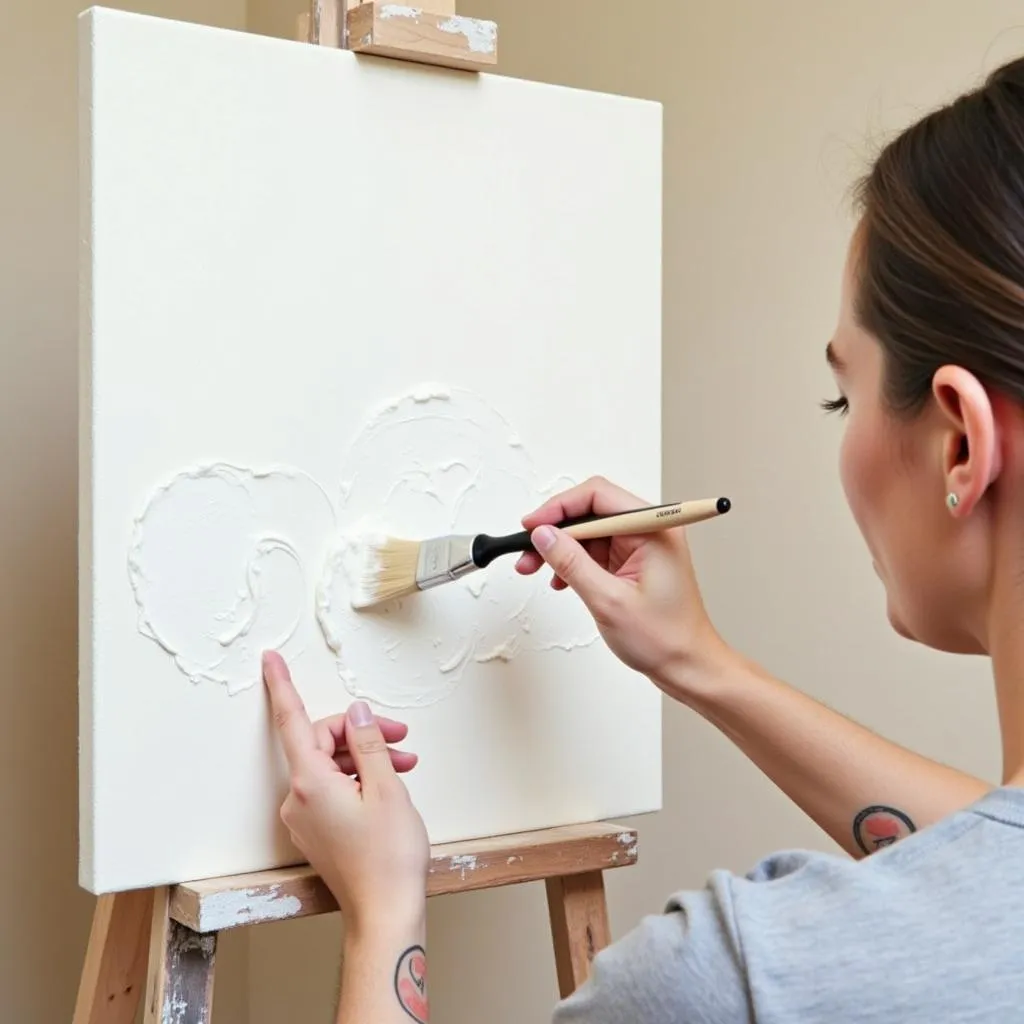Canvas, the unsung hero of countless masterpieces, often fades into the background, allowing vibrant colors to take center stage. But have you ever stopped to wonder, “What color is canvas, really?” Contrary to popular belief, canvas doesn’t exist as a single, uniform shade. Its color can vary depending on several factors, making it a surprisingly nuanced and fascinating subject.
Deciphering the Natural Color of Canvas
In its purest form, canvas boasts a pale, yellowish-brown hue reminiscent of unbleached linen or raw cotton. This natural coloring comes from the fibers of the flax plant, which are woven together to create the canvas fabric. The intensity of this yellowish-brown can differ based on the specific type of flax used, the growing conditions, and the processing methods employed.
 Close-up of natural canvas fabric texture
Close-up of natural canvas fabric texture
Priming the Canvas: A Blank Slate for Creativity
Before an artist picks up a brush, canvas typically undergoes a transformation through a process called “priming.” Priming involves applying a layer of gesso, a mixture traditionally made from rabbit skin glue and chalk, to the canvas surface. This crucial step serves several purposes:
- Creating a smooth, consistent surface: Gesso fills in the natural irregularities of the canvas weave, providing a smoother surface for paint application. This ensures that the paint adheres evenly and prevents it from seeping into the canvas fibers.
- Protecting the canvas: Gesso acts as a barrier between the canvas fibers and the paint, protecting the fabric from the potentially damaging effects of oil paints over time.
- Enhancing color vibrancy: The white or off-white color of gesso provides a neutral background that enhances the vibrancy and luminosity of the applied paint colors.
Primed canvas, with its smooth, white surface, has become synonymous with the very idea of a blank canvas—a space brimming with artistic potential.
 Artist applying gesso to a canvas
Artist applying gesso to a canvas
Beyond the White Canvas: Exploring Tonal Variations
While white remains the most common choice for priming, artists often experiment with different gesso colors to achieve specific effects. Tinted gesso, created by adding pigments to the gesso mixture, can dramatically alter the mood and atmosphere of a painting. For instance:
- Warm undertones: Using a gesso tinted with warm colors like ochre or burnt sienna can create a luminous, inviting base for landscapes or portraits.
- Cool undertones: A gesso tinted with cool colors like blue or gray can lend a sense of serenity or drama to seascapes or abstract works.
- Textured effects: Artists may also choose to leave the gesso layer textured, adding another dimension to their artwork by allowing the brushstrokes to create visible patterns.
“Choosing the right canvas color is like choosing the key in music,” says renowned art instructor, Emily Carter. “It sets the tone for the entire composition and can subtly influence the way colors interact with each other.”
Factors Influencing Canvas Color Perception
It’s important to note that the perceived color of canvas can also be influenced by external factors, including:
- Lighting conditions: Natural daylight versus artificial light can significantly alter how we perceive colors. The same canvas can appear warmer under sunlight and cooler under fluorescent lighting.
- Surrounding colors: The colors surrounding the canvas can create optical illusions, making the canvas appear slightly different in hue or saturation.
- Digital representation: When viewing images of canvases online, keep in mind that screen calibrations can vary, leading to slight discrepancies in color accuracy.
Conclusion: Embracing the Nuances of Canvas Color
So, the next time you encounter a blank canvas, take a moment to appreciate its subtle beauty and the role it plays in shaping artistic expression. Whether it’s the natural yellowish-brown of raw canvas or the pristine white of a primed surface, the color of canvas is not merely incidental—it’s an integral part of the artistic journey, influencing the final masterpiece in both subtle and profound ways.
FAQs
1. Can I paint directly on unprimed canvas?
While it’s technically possible, it’s not recommended. Unprimed canvas is more absorbent, which can lead to uneven paint application and potential damage to the fabric over time.
2. What are the alternatives to traditional gesso?
Acrylic gesso, made from acrylic polymer emulsion, is a popular alternative to traditional rabbit skin glue gesso. It offers similar benefits in terms of surface preparation and protection.
3. Can I tint acrylic gesso myself?
Yes, you can easily tint acrylic gesso by adding small amounts of acrylic paint to the gesso mixture. Experiment with different ratios to achieve the desired color.
4. Where can I buy tinted gesso?
Tinted gesso is available at most art supply stores. You can also find a wide variety of pre-tinted gesso options online.
5. What if I want to change the color of a previously painted canvas?
You can apply a new layer of gesso over a previously painted canvas to create a fresh surface. However, make sure the old paint layer is completely dry and stable before applying the new gesso.
Interested in exploring other color-related queries? Check out these insightful articles:
Need help choosing the perfect colors for your next project? Contact Color Box Hanoi!
Our team of color experts is here to provide personalized guidance and help you create a space that reflects your unique style.
Get in touch today!
Phone: 0373298888
Email: [email protected]
Address: 86 Cầu Giấy, Hà Nội
We offer 24/7 customer support to answer all your color-related questions.

